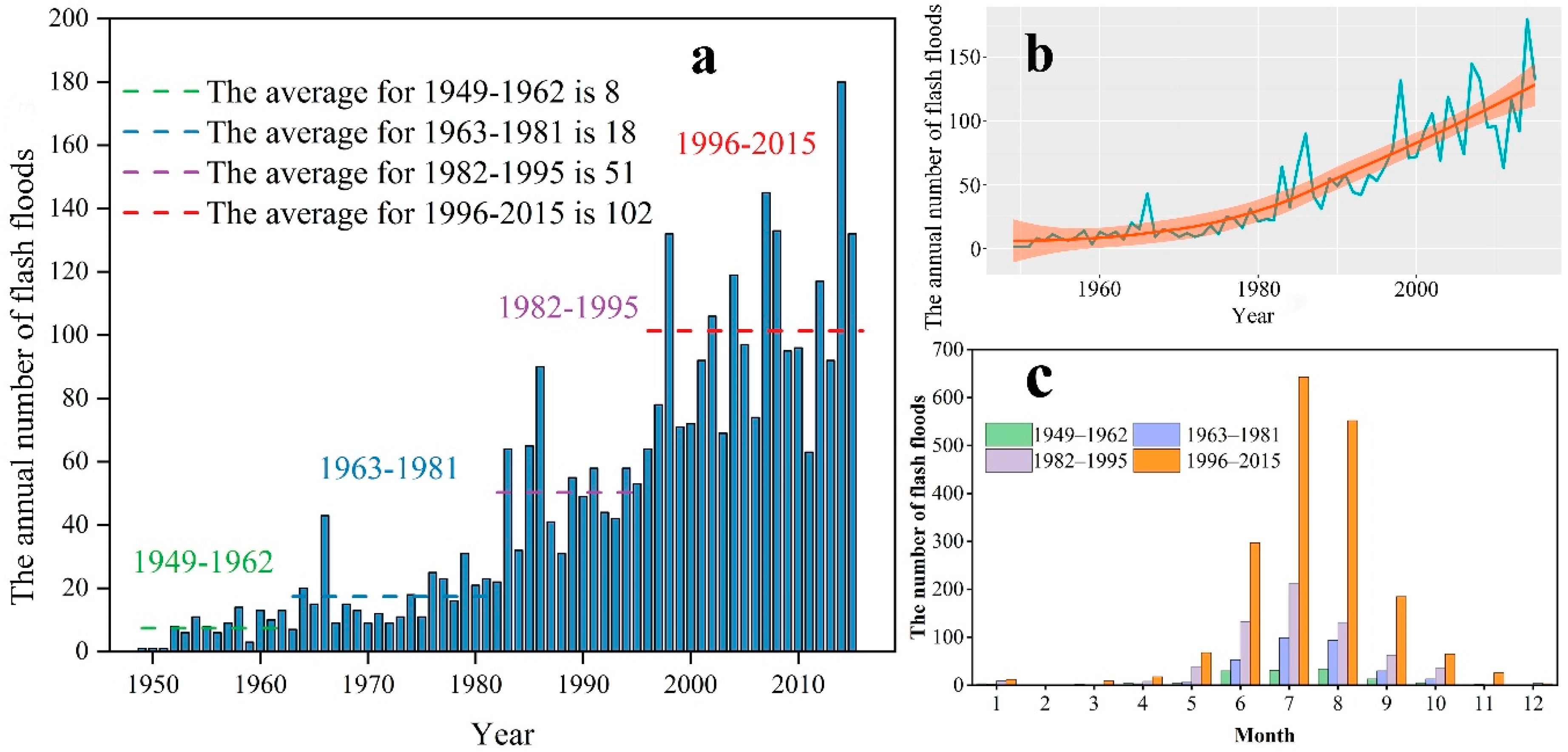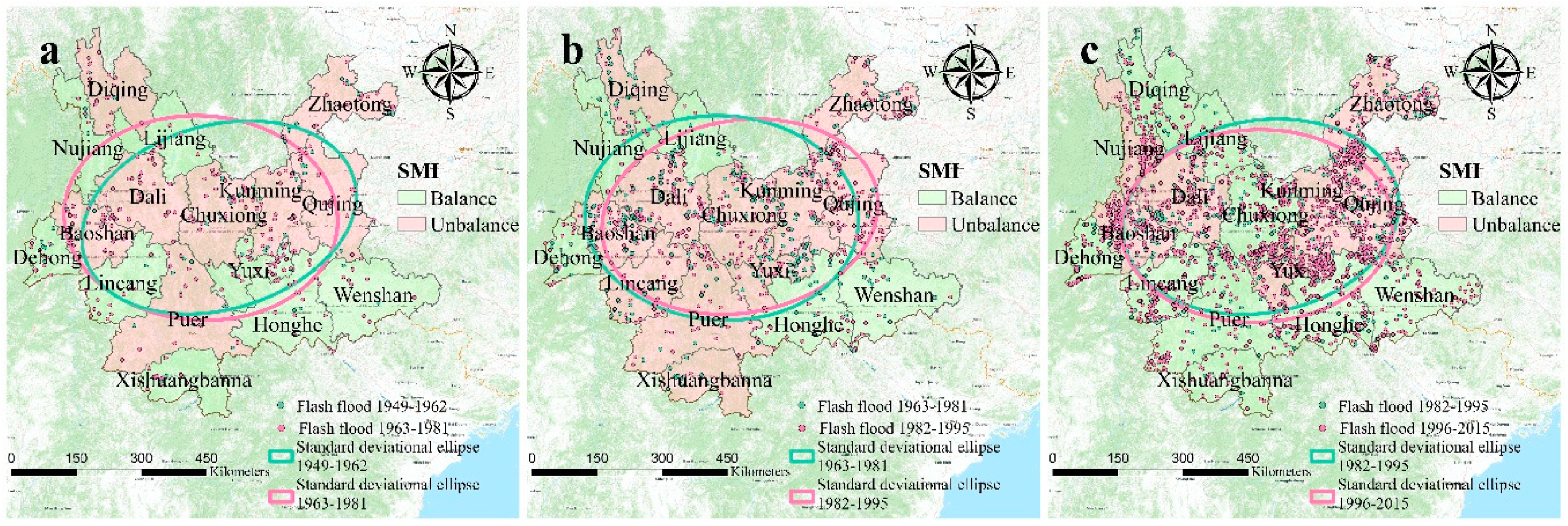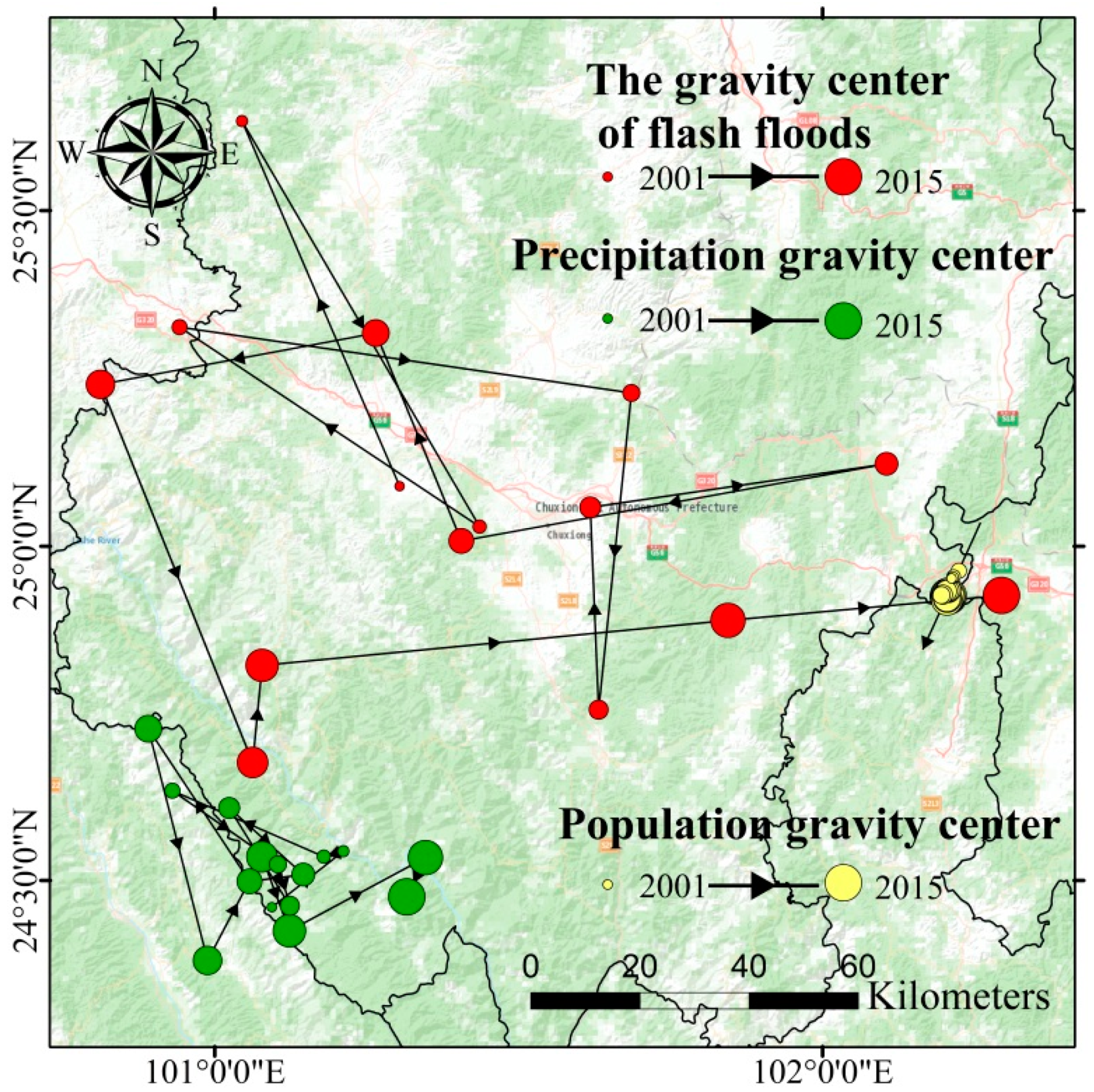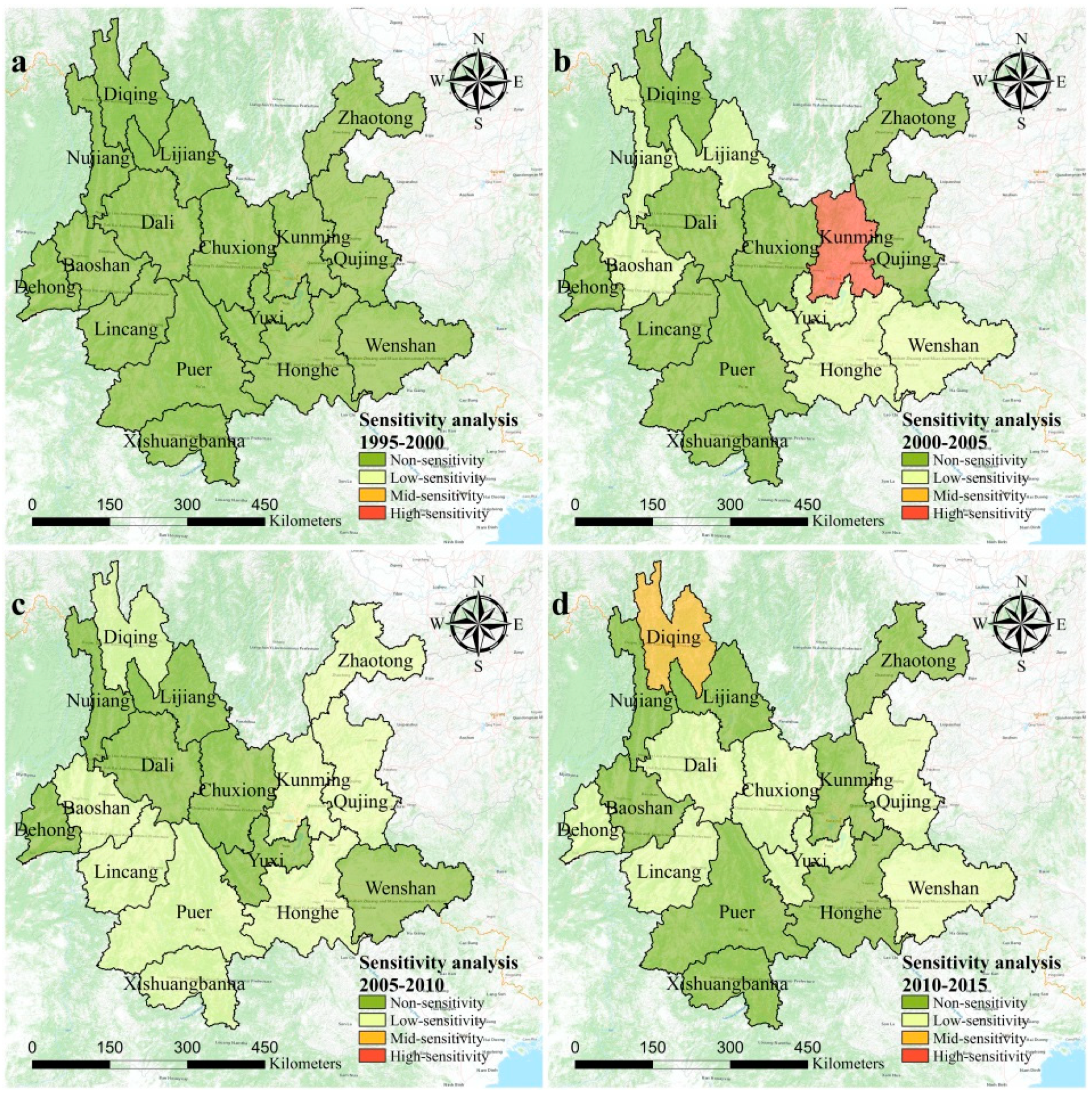The Spatiotemporal Distribution of Flash Floods and Analysis of Partition Driving Forces in Yunnan Province
Abstract
:1. Introduction
2. Materials and Methods
2.1. Study Area
2.2. Selection and Pretreatment of Data
2.3. Methodology
2.3.1. Temporal Pattern
2.3.2. Spatial Pattern
2.3.3. Driving Force Analysis
2.3.4. Sensitivity analysis
3. Results
3.1. Temporal Pattern of the Flash Floods
3.2. Spatial Pattern of the Flash Floods
3.2.1. The Result of Kernel Density Estimation
3.2.2. Results of Spatial Mismatch Analysis and SDE
3.2.3. Results of the Spatial Gravity Center Model
3.3. Driving Factors for the Spatial Distribution of the Flash Floods
3.4. Sensitivity Analysis between the Flash Floods and Economy Development
4. Discussion
4.1. Temporal and Spatial Distribution of the Flash Floods
4.2. Driving Factors Influencing the Flash Floods in Yunnan Province
4.3. Sensitivity Analysis of the Flash Floods to Economic Development
5. Conclusions
Author Contributions
Funding
Conflicts of Interest
References
- Gascón, E.; Laviola, S.; Merino, A.; Miglietta, M.M. Analysis of a localized flash-flood event over the central Mediterranean. Atmos. Res. 2016, 182, 256–268. [Google Scholar] [CrossRef]
- Rahman, M.T.; Aldosary, A.S.; Nahiduzzaman, K.M.; Reza, I. Vulnerability of flash flooding in Riyadh, Saudi Arabia. Nat. Hazards 2016, 84, 1807–1830. [Google Scholar] [CrossRef]
- Lian, J.; Yang, W.; Xu, K.; Ma, C. Flash flood vulnerability assessment for small catchments with a material flow approach. Nat. Hazards 2017, 88, 699–719. [Google Scholar] [CrossRef]
- Ashley, S.T.; Ashley, W.S. Flood Fatalities in the United States. J. Appl. Meteorol. Clim. 2008, 47, 805–818. [Google Scholar] [CrossRef]
- He, B.; Huang, X.; Ma, M.; Chang, Q.; Tu, Y.; Li, Q.; Zhang, K.; Hong, Y. Analysis of flash flood disaster characteristics in China from 2011 to 2015. Nat. Hazards 2017, 90, 407–420. [Google Scholar] [CrossRef]
- Gourley, J.J.; Flamig, Z.L.; Vergara, H.; Kirstetter, P.-E.; Clark, R.A.; Argyle, E.; Arthur, A.; Martinaitis, S.; Terti, G.; Erlingis, J.M.; et al. The FLASH project: Improving the tools for flash flood monitoring and prediction across the United States. Bull. Am. Meteorol. Soc. 2017, 98, 361–372. [Google Scholar] [CrossRef]
- Barredo, J.I. Major flood disasters in Europe: 1950–2005. Nat. Hazards 2006, 42, 125–148. [Google Scholar] [CrossRef]
- Pereira, S.; Diakakis, M.; Deligiannakis, G.; Zêzere, J.L. Comparing flood mortality in Portugal and Greece (Western and Eastern Mediterranean). Int. J. Disaster Risk Reduct. 2017, 22, 147–157. [Google Scholar] [CrossRef]
- Xu, J.; Wilkes, A. Biodiversity impact analysis in northwest Yunnan, southwest China. Biodivers. Conserv. 2004, 13, 959–983. [Google Scholar] [CrossRef]
- Zeng, Z.; Tang, G.; Long, D.; Zeng, C.; Ma, M.; Hong, Y.; Xu, H.; Xu, J. A cascading flash flood guidance system: Development and application in Yunnan Province, China. Nat. Hazards 2016, 84, 2071–2093. [Google Scholar] [CrossRef]
- Bajabaa, S.; Masoud, M.; Al-Amri, N. Flash flood hazard mapping based on quantitative hydrology, geomorphology and GIS techniques (case study of Wadi Al Lith, Saudi Arabia). Arab. J. Geosci. 2013, 7, 2469–2481. [Google Scholar] [CrossRef]
- Shi, P.; Lili, L.; Wang, M.; Wang, J.; Chen, W. Disaster system: Disaster cluster, disaster chain and disaster compound. J. Nat. Disasters 2014, 23, 1–12. [Google Scholar]
- Zhong, D.; Xie, H.; Wei, F.; Liu, H.; Tang, J. Discussion on Mountain Hazards Chain. J. Mt. Sci. 2013, 31, 314–326. [Google Scholar]
- Xiong, J.; Wei, F.; Liu, Z. Hazard assessment of debris flow in Sichuan Province. J. Geo-Inf. Sci. 2017, 19, 1604–1612. [Google Scholar]
- Zeleňáková, M.; Gaňová, L.; Purcz, P.; Satrapa, L. Methodology of flood risk assessment from flash floods based on hazard and vulnerability of the river basin. Nat. Hazards 2015, 79, 2055–2071. [Google Scholar] [CrossRef]
- Guo, E.; Zhang, J.; Ren, X.; Zhang, Q.; Sun, Z. Integrated risk assessment of flood disaster based on improved set pair analysis and the variable fuzzy set theory in central Liaoning Province, China. Nat. Hazards 2014, 74, 947–965. [Google Scholar] [CrossRef]
- Sangati, M.; Borga, M. Influence of rainfall spatial resolution on flash flood modelling. Nat. Hazards Earth Syst. Sci. 2009, 9, 575–584. [Google Scholar] [CrossRef] [Green Version]
- Lin, Z.; Nimaji; Huang, Z. Hydrological dynamics simulation and critical rainfall for flash flood in southeastern Tibet. Bull. Soil Water Conserv. 2017, 37, 183–187. [Google Scholar]
- Jun, D.U.; Wen-Feng, D.; Hong-Yu, R. Relationships between different types of flash flood disasters and their main impact factors in the Sichuan Province. Resour. Environ. Yangtze Basin 2015, 24, 1977–1983. [Google Scholar]
- Wan, S.; Zhao, N.; Wei, D. Correlation and multi-timescale characteristics of strong precipitations and landslide debris flows in Yunnan Province. J. Catastrophol. 2015, 30, 45–50. [Google Scholar]
- Xiong, J.; Zhao, Y.; Cheng, W.; Guoliang; Wang, N.; Li, W. Temporal and spatial variation rule and influencing ractors of flash floods in Sichuan Province. J. Geo-Inf. Sci. 2018, 20, 1443–1456. [Google Scholar]
- Chen, C.-C.; Tseng, C.-Y.; Dong, J.-J. New entropy-based method for variables selection and its application to the debris-flow hazard assessment. Eng. Geol. 2007, 94, 19–26. [Google Scholar] [CrossRef] [Green Version]
- Tang, C.; van Asch, T.W.; Chang, M.; Chen, G.Q.; Zhao, X.H.; Huang, X.C. Catastrophic debris flows on 13 August 2010 in the Qingping area, southwestern China: The combined effects of a strong earthquake and subsequent rainstorms. Geomorphology 2012, 139, 559–576. [Google Scholar] [CrossRef]
- Vennari, C.; Parise, M.; Santangelo, N.; Santo, A. A database on flash flood events in Campania, southern Italy, with an evaluation of their spatial and temporal distribution. Nat. Hazards Earth Syst. Sci. 2016, 16, 2485–2500. [Google Scholar] [CrossRef] [Green Version]
- Liu, Y.; Yang, Z.; Huang, Y.; Liu, C. Spatiotemporal evolution and driving factors of China’s flash flood disasters since 1949. Sci. China Earth Sci. 2018, 61, 1804–1817. [Google Scholar] [CrossRef]
- Jun, D.U.; Ren, H.; Zhang, P.; Zhang, C. Comparative study of the hazard assessment of mountain torrent disasters in macro scale. J. Catastrophol. 2016, 31, 66–72. [Google Scholar]
- Rozalis, S.; Morin, E.; Yair, Y.; Price, C. Flash flood prediction using an uncalibrated hydrological model and radar rainfall data in a Mediterranean watershed under changing hydrological conditions. J. Hydrol. 2010, 394, 245–255. [Google Scholar] [CrossRef]
- Doocy, S.; Daniels, A.; Murray, S.; Kirsch, T.D. The human impact of floods: A historical review of events 1980-2009 and systematic literature review. PLoS Curr. Disasters 2013, 5, 1808–1815. [Google Scholar] [CrossRef] [PubMed]
- Liu, Y.; Yuan, X.; Guo, L.; Huang, Y.; Zhang, X. Driving force analysis of the temporal and spatial distribution of flash floods in Sichuan Province. Sustainability 2017, 9, 1527. [Google Scholar] [CrossRef]
- Wang, J.; Xu, C. Geodetector: Principle and prospective. Acta Geogr. Sin. 2017, 72, 116–134. [Google Scholar]
- Zhou, L.; Zhou, C.; Yang, F.; Wang, B.; Sun, D. Spatio-temporal evolution and the influencing factors of PM2.5 in China between 2000 and 2011. Acta Ecol. Sin. 2017, 72, 161–174. [Google Scholar]
- Shi, J.; Li, B.; Li, P.; Huang, J.; Sun, F.; Liu, B. Analisis of characteristics and formation mechanism for the 9·17 giant debris flow in Yuanmou Country, Yunnan Province. Geol. Rev. 2018, 64, 665–673. [Google Scholar]
- Xu, S.; Yuan, Z.; Yang, Z. Based on EKC analysis of landslide and debris flow disasters. Soil Water Conserv. China 2015, 54–56. [Google Scholar]
- Zhan, W.; Li, F.; Hao, W.; Yan, J. Regional characteristics and influnencing factors of seasonal vertical crustal motions in Yunnan, China. Geophys. J. Int. 2017, 210, 1295–1304. [Google Scholar] [CrossRef]
- Yang, Y.; Jia, W. Types and geographical environment elements of township placenames in Yunnan Province. Geogr. Res. 2016, 4, 60. [Google Scholar]
- Cao, X.; Pan, W.; Zhou, S.; Han, Z.; Han, T.; Shui, Z. Seasonal variability of oxygen and hydrogen isotopes in a wetland system of the Yunnan-Guizhou Plateau, southwest China: A quantitative assessment of groundwater inflow fluxes. Hydrogeol. J. 2017, 26, 1–17. [Google Scholar] [CrossRef]
- Liu, Y.; Zhao, E.; Huang, W.; Zhou, J.; Ju, J. Characteristic analysis of precipitation and temperature change trend in Yunnan in recent 46 years. J. Catastrophol. 2010, 25, 39–44. [Google Scholar]
- Killick, R.; Fearnhead, P.; Eckley, I.A. Optimal Detection of Changepoints With a Linear Computational Cost. J. Am. Stat. Assoc. 2012, 107, 1590–1598. [Google Scholar] [CrossRef]
- Guo, F.; Innes, J.L.; Wang, G.; Ma, X.; Sun, L.; Hu, H.; Su, Z. Historic distribution and driving factors of human-caused fires in the Chinese boreal forest between 1972 and 2005. J. Plant Ecol. 2015, 8, 480–490. [Google Scholar] [CrossRef]
- Chai, J.; Wang, Z.; Yang, J.; Zhang, L. Analysis for spatial-temporal changes of grain production and farmland resource: Evidence from Hubei Province, central China. J. Clean. Prod. 2019, 207, 474–482. [Google Scholar] [CrossRef]
- Li, T.; Long, H.; Zhang, Y.; Tu, S.; Ge, D.; Li, Y.; Hu, B. Analysis of the spatial mismatch of grain production and farmland resources in China based on the potential crop rotation system. Land Use Policy 2017, 60, 26–36. [Google Scholar] [CrossRef]
- Wang, B.; Shi, W.; Miao, Z. Confidence analysis of standard deviational ellipse and its extension into higher dimensional euclidean space. PLoS ONE 2015, 10, e0118537. [Google Scholar] [CrossRef]
- Li, M.; Ren, X.; Zhou, L.; Zhang, F. Spatial mismatch between pollutant emission and environmental quality in China—A case study of NOx. Atmos. Pollut. Res. 2016, 7, 294–302. [Google Scholar] [CrossRef]
- Irhoumah, M.; Pusca, R.; Lefèvre, E.; Mercier, D.; Romary, R. Diagnosis of induction machines using external magnetic field and correlation coefficient 2017. In Proceedings of the 2017 IEEE 11th International Symposium on Diagnostics for Electrical Machines, Power Electronics and Drives (SDEMPED), Tinos, Greece, 29 August–1 September 2017; pp. 531–536. [Google Scholar]
- Wang, H.; Zhang, B.; Liu, Y.; Liu, Y.; Xu, S.; Deng, Y.; Zhao, Y.; Chen, Y.; Hong, S. Multi-dimensional analysis of urban expansion patterns and their driving forces based on the center of gravity-GTWR model: Acase study of the Beijing-Tianjin-Hebei urban agglomeration. Acta Geogr. Sin. 2018, 73, 1076–1092. [Google Scholar]
- Abdi, H.; Williams, L.J. Principal component analysis. Wiley Interdiscip. Rev. Comput. Stat. 2010, 2, 433–459. [Google Scholar] [CrossRef]
- Khademi, F.; Akbari, M.; Jamal, S.M.; Nikoo, M. Multiple linear regression, artificial neural network, and fuzzy logic prediction of 28 days compressive strength of concrete. Front. Struct. Civ. Eng. 2017, 11, 90–99. [Google Scholar] [CrossRef]
- Han, Z.; Song, W.; Deng, X. Responses of ecosystem service to land use change in Qinghai Province. Energies 2016, 9, 303. [Google Scholar] [CrossRef]
- Yu, W.; Shao, M.; Ren, M.; Zhou, H.; Jiang, Z.; Li, D. Analysis on spatial and temporal characteristics drought of Yunnan Province. Acta Ecol. Sin. 2013, 33, 317–324. [Google Scholar] [CrossRef]
- Liu, L.; Xu, Z.X. Regionalization of precipitation and the spatiotemporal distribution of extreme precipitation in southwestern China. Nat. Hazards 2015, 80, 1195–1211. [Google Scholar] [CrossRef]
- Liu, J.; Li, L.; Li, J.; Wang, Z.; Chen, S.; Zhang, K. Characteristics of precipitation variation and potential drought-flood regional responses in Yunnan Province from 1954 to 2014. J. Geo-Inf. Sci. 2016, 18, 1077–1086. [Google Scholar]
- Tao, Y.; He, Q. The temporal and spatial distribution of precipitation over Yunnan province and its response to global warming. J. Yunnan Univ. 2008, 30, 587–595. [Google Scholar]
- Luo, J.; Zhan, J.; Lin, Y.; Zhao, C. An equilibrium analysis of the land use structure in the Yunnan Province, China. Front. Earth Sci. 2014, 8, 393–404. [Google Scholar] [CrossRef]
- Liu, X.; Salmeron, D.; Luo, Q.; Rana, S.; Liu, Z. Research on optimal development pattern of Yunnan central economic region. China City Plan. Rev. 2012, 21, 38–45. [Google Scholar]
- Zhang, M.; Zhou, Z.; Chen, W.; Slik, J.W.F.; Cannon, C.H.; Raes, N. Using species distribution modeling to improve conservation and land use planning of Yunnan, China. Boil. Conserv. 2012, 153, 257–264. [Google Scholar] [CrossRef]
- Han, Z.; Song, W.; Deng, X.; Xu, X. Grassland ecosystem responses to climate change and human activities within the Three-River Headwaters region of China. Sci. Rep. 2018, 8, 9079. [Google Scholar] [CrossRef] [PubMed]
- Špitalar, M.; Gourley, J.J.; Lutoff, C.; Kirstetter, P.-E.; Brilly, M.; Carr, N. Analysis of flash flood parameters and human impacts in the US from 2006 to 2012. J. Hydrol. 2014, 519, 863–870. [Google Scholar] [CrossRef]
- Jenerette, G.D.; Harlan, S.L.; Brazel, A.; Jones, N.; Larsen, L.; Stefanov, W.L. Regional relationships between surface temperature, vegetation, and human settlement in a rapidly urbanizing ecosystem. Landsc. Ecol. 2006, 22, 353–365. [Google Scholar] [CrossRef]
- Luo, H. Dynamic of vegetation carbon storage of farmland ecosystem in hilly area of central Sichuan Basin during the Last 55 years—A case study of Yanting County, Sichuan Province. J. Nat. Resour. 2009, 24, 251–258. [Google Scholar]
- Peng, L.; Deng, W.; Zhang, H.; Sun, J.; Xiong, J. Focus on economy or ecology? A three-dimensional trade-off based on ecological carrying capacity in southwest China. Nat. Resour. Model. 2018, 32, e12201. [Google Scholar] [CrossRef]
- Kourgialas, N.N.; Karatzas, G.P.; Nikolaidis, N.P. Development of a thresholds approach for real-time flash flood prediction in complex geomorphological river basins. Hydrol. Process. 2012, 26, 1478–1494. [Google Scholar] [CrossRef]
- Chou, J.; Xian, T.; Dong, W.; Xu, Y. Regional temporal and spatial trends in drought and flood disasters in China and assessment of economic losses in recent years. Sustainability 2018, 11, 55. [Google Scholar] [CrossRef]
- Tang, W.; Zhou, T.; Sun, J.; Li, Y.; Li, W. Accelerated urban expansion in Lhasa City and the implications for sustainable development in a Plateau city. Sustainability 2017, 9, 1499. [Google Scholar] [CrossRef]
- Yi, S.; Yang, J.; Hu, X. How economic globalization affects urban expansion: An empirical analysis of 30 Chinese provinces for 2000–2010. Qual. Quant. 2016, 50, 1117–1133. [Google Scholar]
- Hu, S.; Yan, X.; Qu, D.; Li, X. Approach to the legislative problem of the recycling economy in Kunming. Ecol. Econ. 2005, 1, 92–96. [Google Scholar]
- Gao, J.; Wei, Y.; Chen, W.; Yenneti, K. Urban land expansion and structural change in the Yangtze River Delta, China. Sustainability 2015, 7, 10281–10307. [Google Scholar] [CrossRef]







| Factors | Source |
|---|---|
| Flash floods | China: Flash Flood Investigation and Evaluation Dataset of China, 1949–2015, 1:50,000, vector data. |
| Precipitation factors | China: Flash Flood Investigation and Evaluation Dataset of China, vector data. |
| DEM | China: Geospatial Data Cloud, 2000, 90 m × 90 m, raster data. |
| Population density | China: Resources and Environmental Sciences Data Center, 2000, 2005,2010, and 2015, 1 km × 1 km, raster data. |
| GDP | China: Resources and Environmental Sciences Data Center, 1995, 2000, 2005, 2010, and 2015, 1 km × 1 km, raster data. |
| Normalized difference vegetation index | USA: NASA’s MODIS web site, 2001–2015, 1 km × 1 km, raster data. |
| Landcover | China: Global Change Research Data Publishing & Repository, 2010, 1 km × 1 km, raster data. |
| r Value | Correlation Level |
|---|---|
| r = 0 | no correlation |
| 0 < ∣r∣ < 0.2 | very weak correlation |
| 0.2 < ∣r∣ < 0.4 | weak correlation |
| 0.4 < ∣r∣ < 0.6 | intermediate correlation |
| 0.6 < ∣r∣ < 0.8 | strong correlation |
| 0.8 < ∣r∣ < 1 | very strong correlation |
| ∣r∣ = l | perfect correlation |
| S Value | Sensitivity Level | Description |
|---|---|---|
| S ≤ 0 | Non-sensitivity | It indicates the changes in the flash floods and economic development do not have any synchronized characteristics. |
| 0 < S ≤ 10 | Low-sensitivity | It indicates the flash floods have low sensitivity to economic development. |
| 10 < S ≤ 20 | Mid-sensitivity | It indicates the flash floods have medium sensitivity to economic development. |
| S > 20 | High-sensitivity | It indicates the flash floods have high sensitivity to economic development. |
| Year Interval | Year | June | July | August |
|---|---|---|---|---|
| 1949–1962 | 104 | 30 | 31 | 34 |
| 1963–1981 | 331 | 53 | 99 | 94 |
| 1982–1995 | 704 | 133 | 213 | 131 |
| 1996–2015 | 2027 | 297 | 643 | 552 |
| Factors | Grassland | Settlement | Farmland | Forest | ||||
|---|---|---|---|---|---|---|---|---|
| r | P | r | P | r | P | r | P | |
| M10_20 | 0.487 | <0.001 | 0.675 | <0.001 | 0.445 | <0.001 | 0.466 | <0.001 |
| M60_20 | 0.335 | 0.001 | 0.593 | <0.001 | 0.348 | 0.001 | 0.326 | 0.001 |
| H6_20 | 0.449 | <0.001 | 0.395 | <0.001 | 0.445 | <0.001 | 0.492 | <0.001 |
| H24_20 | 0.501 | <0.001 | 0.519 | <0.001 | 0.381 | <0.001 | 0.485 | <0.001 |
| ELE | 0.431 | <0.001 | 0.674 | <0.001 | 0.402 | <0.001 | 0.257 | 0.01 |
| TR | −0.077 | 0.446 | −0.146 | 0.172 | 0.219 | 0.032 | −0.014 | 0.888 |
| SLP | −0.05 | 0.619 | −0.094 | 0.382 | −0.176 | 0.085 | −0.081 | 0.424 |
| NDVI | −0.241 | 0.016 | 0.061 | 0.571 | −0.222 | 0.029 | −0.234 | 0.02 |
| PD | 0.082 | 0.42 | −0.211 | 0.048 | 0.108 | 0.297 | −0.098 | 0.335 |
| GDP | 0.098 | 0.332 | 0.042 | 0.697 | 0.226 | 0.027 | 0.233 | 0.02 |
© 2019 by the authors. Licensee MDPI, Basel, Switzerland. This article is an open access article distributed under the terms and conditions of the Creative Commons Attribution (CC BY) license (http://creativecommons.org/licenses/by/4.0/).
Share and Cite
Xiong, J.; Ye, C.; Cheng, W.; Guo, L.; Zhou, C.; Zhang, X. The Spatiotemporal Distribution of Flash Floods and Analysis of Partition Driving Forces in Yunnan Province. Sustainability 2019, 11, 2926. https://0-doi-org.brum.beds.ac.uk/10.3390/su11102926
Xiong J, Ye C, Cheng W, Guo L, Zhou C, Zhang X. The Spatiotemporal Distribution of Flash Floods and Analysis of Partition Driving Forces in Yunnan Province. Sustainability. 2019; 11(10):2926. https://0-doi-org.brum.beds.ac.uk/10.3390/su11102926
Chicago/Turabian StyleXiong, Junnan, Chongchong Ye, Weiming Cheng, Liang Guo, Chenghu Zhou, and Xiaolei Zhang. 2019. "The Spatiotemporal Distribution of Flash Floods and Analysis of Partition Driving Forces in Yunnan Province" Sustainability 11, no. 10: 2926. https://0-doi-org.brum.beds.ac.uk/10.3390/su11102926





